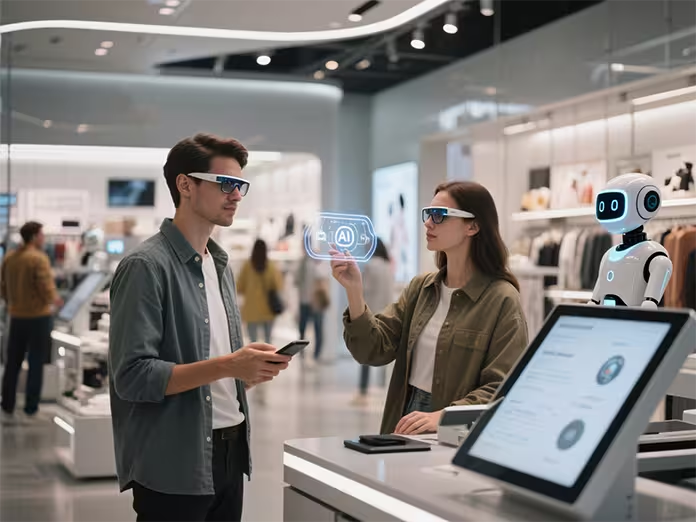
The retail landscape is undergoing its most dramatic transformation yet. Welcome to Retail 5.0 – the revolutionary era where artificial intelligence meets augmented reality to create shopping experiences that seemed impossible just a decade ago. This isn’t just another incremental upgrade; it’s a complete reimagining of how customers interact with brands, products, and retail spaces.
The Evolution to Retail 5.0
While traditional retail focused on transactions and digital retail emphasized convenience, Retail 5.0 centers on creating deeply personalized, immersive experiences that blur the lines between physical and digital worlds. This new paradigm leverages cutting-edge AI algorithms and AR technology to anticipate customer needs, provide real-time assistance, and deliver experiences that adapt to individual preferences in ways previously unimaginable.
The journey from brick-and-mortar stores to Retail 5.0 represents more than technological advancement – it’s a fundamental shift in understanding customer behavior and expectations. Today’s consumers don’t just want to buy products; they want to experience brands, connect emotionally with purchases, and receive service that feels intuitive and natural.
“Retail 5.0: AI & AR Revolution Transforming Shopping.”
AI: The Brain Behind Retail 5.0
Artificial intelligence serves as the cognitive engine powering Retail 5.0 experiences. Advanced machine learning algorithms analyze vast datasets of customer behavior, purchase history, browsing patterns, and even biometric responses to create hyper-personalized shopping journeys.
Smart recommendation engines now go beyond suggesting products based on past purchases. They consider contextual factors like weather, location, time of day, and even social media activity to present options that align perfectly with immediate needs and desires. Voice assistants integrated into retail environments can understand natural language queries, helping customers find products through conversational interfaces that feel more like chatting with a knowledgeable friend than interacting with technology.
Predictive analytics enable retailers to anticipate demand patterns, optimize inventory placement, and even predict when individual customers might be ready to make specific purchases. This level of insight allows for proactive customer service that addresses needs before customers even recognize them.
Augmented Reality: Transforming How We Shop
Retail 5.0 harnesses augmented reality to bridge the gap between online convenience and in-store tactile experiences. AR technology allows customers to visualize products in their own environments before making purchases, dramatically reducing return rates and increasing satisfaction.
Virtual try-on experiences have evolved far beyond simple filters. Advanced AR systems can now accurately simulate how clothing fits different body types, how makeup looks under various lighting conditions, or how furniture appears in specific room layouts. These applications provide confidence in purchase decisions that traditional e-commerce simply cannot match.
Interactive AR mirrors in physical stores offer personalized styling advice, suggesting complementary items and color combinations based on individual skin tone, body shape, and personal style preferences. Customers can experiment with different looks without the time and effort of physical try-ons, making the shopping process both more efficient and more enjoyable.
Seamless Omnichannel Integration
The true power of Retail 5.0 emerges through seamless integration across all customer touchpoints. Mobile apps communicate with in-store systems to provide continuity between digital browsing and physical shopping. Customers can start their journey on social media, research products on mobile devices, and complete purchases in stores without losing personalization or purchase history.
Smart mirrors, interactive displays, and AI-powered kiosks create consistent experiences regardless of the channel customers choose to engage with. This omnichannel approach ensures that customer preferences, loyalty rewards, and personalized recommendations follow them throughout their shopping journey.
Real-World Applications Revolutionizing Retail
Leading retailers are already implementing Retail 5.0 solutions with remarkable results. Virtual showrooms allow customers to explore entire product catalogs in immersive 3D environments. AI-powered chatbots provide 24/7 customer service that rivals human representatives in understanding and problem-solving capabilities.
Smart shelves equipped with sensors and AI can detect when products are running low, automatically reorder inventory, and even adjust pricing based on real-time demand. This technology ensures optimal product availability while maximizing revenue opportunities.
Location-based services combined with AI create micro-targeted marketing campaigns that deliver relevant offers precisely when and where customers are most likely to make purchases. These systems can send personalized promotions to mobile devices as customers approach specific store sections or geographic locations.
The Customer Experience Revolution
Retail 5.0 fundamentally transforms customer expectations and experiences. Shopping becomes less about searching for products and more about discovering solutions that enhance lifestyle and solve problems. AI assistants learn individual preferences over time, becoming more accurate and helpful with each interaction.
Personalization reaches unprecedented levels, with dynamic pricing, customized product recommendations, and tailored marketing messages that speak directly to individual needs and desires. This level of customization creates emotional connections between customers and brands that drive long-term loyalty.
The friction typically associated with shopping – long checkout lines, unavailable sizes, uncertainty about product suitability – dissolves through intelligent automation and predictive service delivery.
Challenges and Considerations
Implementing Retail 5.0 requires significant technological infrastructure and cultural shifts within organizations. Privacy concerns around data collection and AI decision-making demand transparent policies and robust security measures. Retailers must balance personalization with privacy, ensuring customers feel valued rather than surveilled.
The integration of multiple technologies – AI, AR, IoT sensors, mobile platforms – creates complexity that requires careful planning and execution. Success depends on creating cohesive experiences rather than disconnected technological features.
The Future of Retail is Here
Retail 5.0 represents more than a technological upgrade; it’s a fundamental reimagining of commerce that puts customer experience at the center of every decision. As AI becomes more sophisticated and AR technology more accessible, the boundary between digital and physical retail will continue to blur.
Retailers who embrace Retail 5.0 principles – personalization, immersion, intelligence, and seamless integration – will create competitive advantages that are difficult to replicate. The future belongs to brands that can anticipate customer needs, deliver exceptional experiences, and build emotional connections through technology that feels natural and intuitive.
The revolution has begun, and Retail 5.0 is reshaping how we discover, evaluate, and purchase products in ways that make shopping not just more convenient, but genuinely enjoyable and meaningful.




































